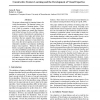Free Online Productivity Tools
i2Speak
i2Symbol
i2OCR
iTex2Img
iWeb2Print
iWeb2Shot
i2Type
iPdf2Split
iPdf2Merge
i2Bopomofo
i2Arabic
i2Style
i2Image
i2PDF
iLatex2Rtf
Sci2ools
ICML
2000
IEEE
2000
IEEE
Constructive Feature Learning and the Development of Visual Expertise
We present a framework for learning features for visual discrimination. The learning system is exposed to a sequence of training images. Whenever it fails to recognize a visual context adequately, new features are sought that discriminate further between the true and false classes. Features consist of hierarchical combinations of primitive features (local edge and texture characteristics) that are sampled from example images. The system continues to learn better features even after all recognition errors have been eliminated, similarly to mechanisms underlying human visual expertise. Whenever the probabilistic recognition algorithm returns any posterior class probabilities greater than zero and less than one, the system attempts to find new features that improve discrimination between the classes in question. Our experiments indicate that this procedure tends to improve classification accuracy on independent test images, while reducing the number of features used for recognition.
Human Visual Expertise | ICML 2000 | Machine Learning | Posterior Class Probabilities | Probabilistic Recognition Algorithm |
| Added | 17 Nov 2009 |
| Updated | 17 Nov 2009 |
| Type | Conference |
| Year | 2000 |
| Where | ICML |
| Authors | Justus H. Piater, Roderic A. Grupen |
Comments (0)

